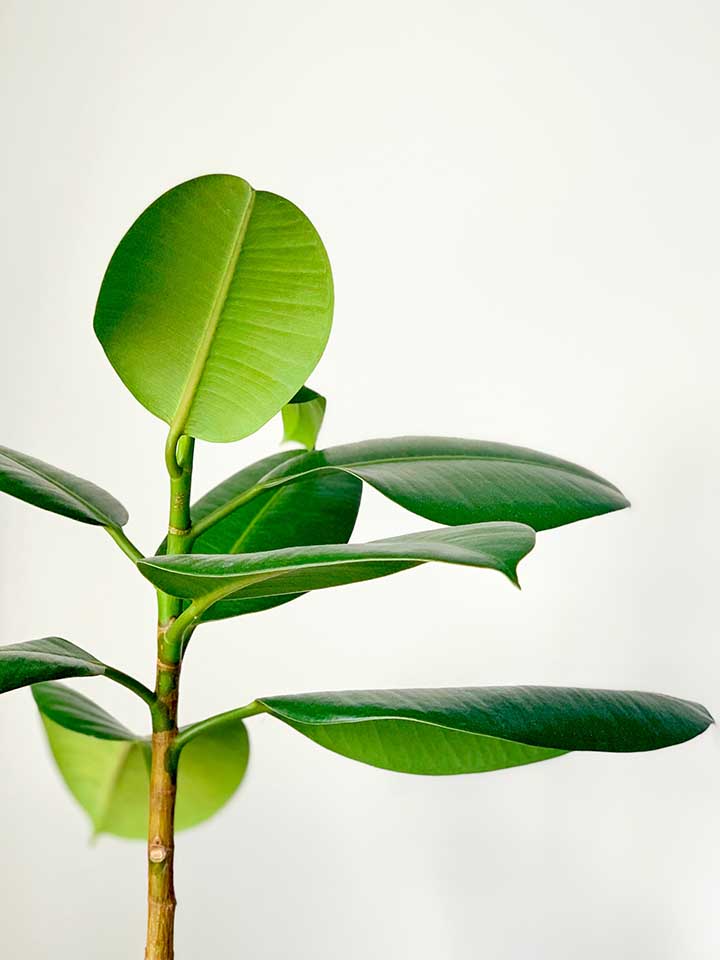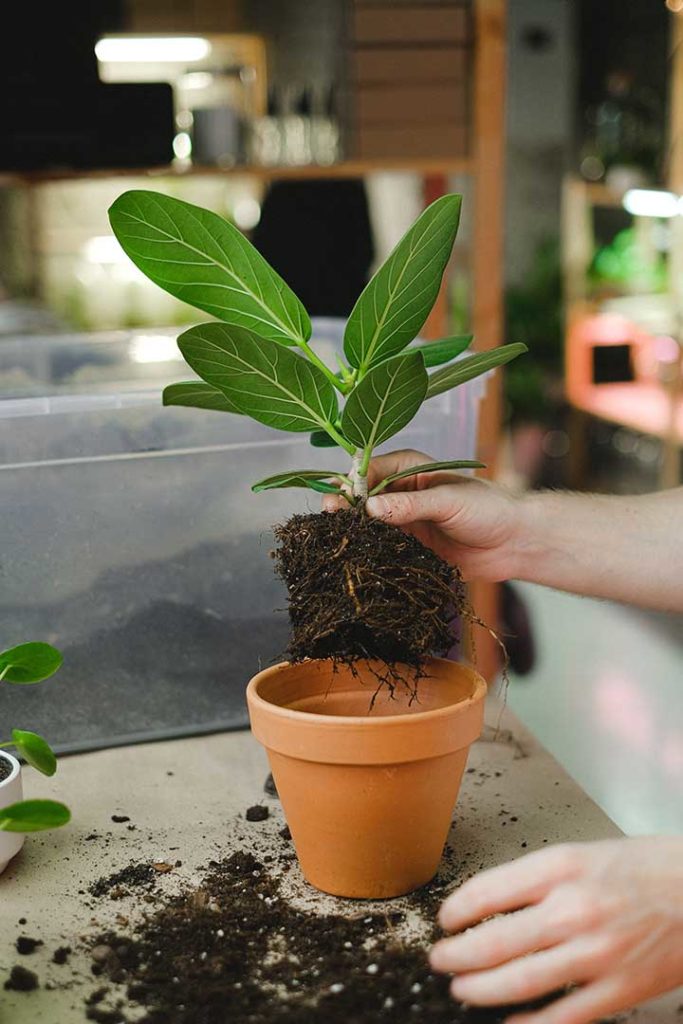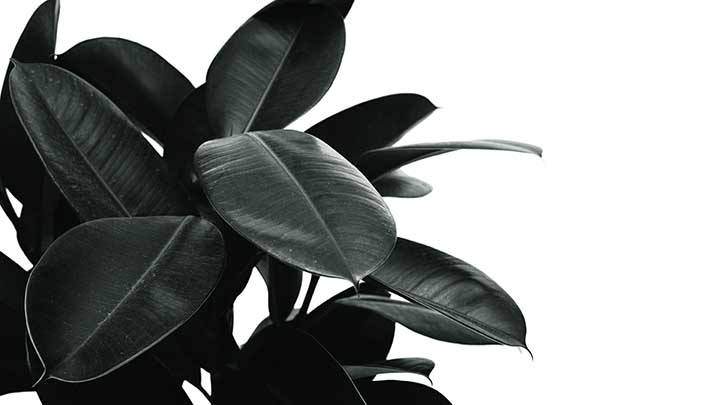Accidents happen. Sometimes we overwater our plants.
How do I fix an overwatered rubber plant? The first step to fixing an overwatered rubber plant is to dry the soil or growing medium out. The second step is deciding whether or not it needs replanting into drier soil. Once your plant is in dry soil again, don’t water it for at least another 1 to 2 weeks. Avoid overwatering again by practicing a watering schedule.
Read on below and explore what happens with overwatered rubber plants, and what to do about it when it does happen!
Table of Contents
How Much Water Does Rubber Plant Need?
Rubber trees require a slightly smaller amount of water than many houseplants, needing additional moisture just once every 10 to 15 days or so.
Between watering sessions, allow your rubber plant’s growing medium to dry out.
Before watering the plant, stick your fingers into 2 or 3 inches of the soil. If your fingers are dry when you pull them out, the plant is ready for watering.
If your fingers come out of the soil wet, or with pieces of soil sticking to them, your rubber plant isn’t ready for additional moisture yet. In this case, check back in a few days and try again.
Alternatively, you may consider investing in a moisture meter to check the soil in between watering.
Your rubber plant’s soil should be wet for a depth of at least 3 to 5 inches, that way the moisture is easily available to the root system.
Signs of Overwatering Rubber Plant
Rubber plants that are overwatered are typically easy to spot. The first indicator that your rubber plant is overwatered is the largest and oldest leaves turning yellow or brown.
The next sign is usually a marked increase in insect activity on and around your plant and its soil.
One of the worst repercussions of overwatering your rubber plant is the increased interest from pests.
Pests may cause far more damage than slow or stunted growth if you don’t reverse the situation quickly.
Another clear piece of evidence that your rubber plant is overwatered is droopy leaves/branches and sudden and/or excessive leaf drop.
Will a Rubber Plant Recover from Overwatering?

Thankfully, most rubber plants are capable of recovering from overwatering. The trick is catching them in time.
If you notice your rubber plant is overwatered within the first few days to a week or so, you can simply stop watering it. Leave the plant alone and let its soil dry out completely before watering again.
If you don’t notice it in time, however, you can’t simply let your plant dry out; you have to transplant it into new soil or another dry growing medium immediately.
When choosing a place to transplant your overwatered rubber plant, look for a nice well-draining spot in the garden. Make sure that it gets plenty of sunlight and has good airflow as well.
Alternatively, you may choose to transplant your rubber plant into a pot or container.
If you opt for this choice, make sure the pot is filled with completely dry soil or growing medium. The pot should also have drain holes.
Overwatered rubber plants that have been transplanted into new pots may also be left in the sun, helping further dry their soggy roots.
Use a moisture meter, or your fingers, and check on the wetness of the root zone every day until your rubber plant is ready for watering once again.
How to Save Overwatered Rubber Plant?

When you overwater your rubber plant, you have a limited amount of time to save it. The first step, of course, is noticing/realizing that the plant is indeed overwatered.
Once you are aware of the fact your rubber plant is overwatered, you can start taking action to save it immediately.
Thankfully, you can save it. Most of the time quite easily, albeit you’ll need a bit of patience and technique for watering your plants in the future.
The first thing you need to do to save your overwatered rubber plant is to stop watering it right away.
Secondly, you must determine whether the plant can remain in the wet soil while it drys, or if the plant needs transplanting.
If your moisture meter is off the charts, or your fingers come out of the soil looking like you stuck them in a mud pie, you’ll need to transplant the rubber plant immediately.
Otherwise, it can remain where it is, without additional watering for several days or weeks.
When you have decided it’s ok where it is, or have already transplanted it, you can quicken its recovery by placing it in the afternoon sun, or somewhere warm with good airflow.
Repeat this special treatment for several days. Keep checking the soil’s moisture level as you go.
When your plant is ready for watering again, it’s ready to return to its former place and watering schedule. But, this time, you won’t likely overwater it again!
What Causes Overwater on Rubber Plant & Solution to Prevent
There are a few common reasons behind rubber plants being overwatered.
Below, we have a closer look at each one:
Human Errors and Miscommunication
The biggest reason for overwatering a rubber plant is human error and miscommunication.
For example, you may simply pour out a liter or two more than necessary every time you water your rubber plant.
Likewise, you could water your plant just fine… except your husband, wife, or someone else also waters the rubber plant unknowingly.
Solution
There are several suitable solutions for cutting back on human error and miscommunication in regards to watering your rubber plant.
You can download and use an app, keep track of watering sessions in a notebook, and/or have frequent conversations about who is watering what around the home and garden.
Severe or Unexpected Weather
The next most common reason for overwatering of rubber plants is mother nature.
Whether it’s unexpected rain, or a large and slow-moving storm system, any amount of additional water (on top of what you already provide your rubber plant) can be enough to cause overwatering issues.
Solution
Keep an eye on the local weather channel, or install and use a weather app with automatic updates and notifications for rain and storms.
Take appropriate action when it does rain or storm, such as covering your plants or otherwise moving them out of the rain.
Angry Yard Gnomes
For those who dare keep gnomes in their yard or garden; beware!
An angry yard gnome may want to see all your hard work in maintaining your plants undone.
In this case, your rubber plant may mysteriously become overwatered overnight.
Solution
Give your gnome statutes plenty of attention, including fresh paint from time to time. Avoid bumping, knocking over, or damaging your gnomes.
